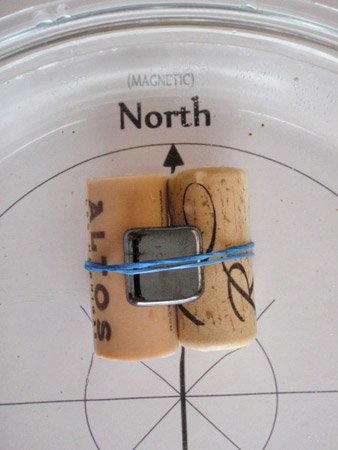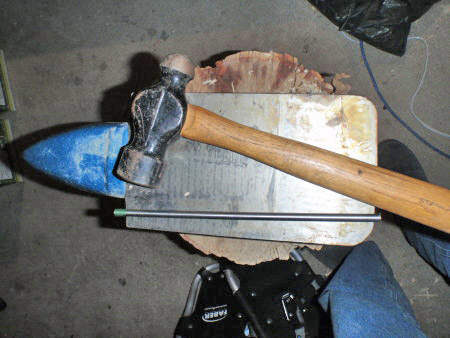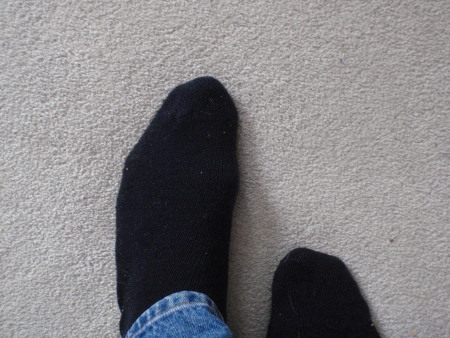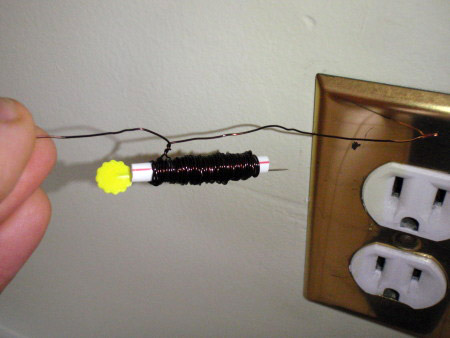|
|
Home →
Survival →
Navigation
Improvised Compass
by Rob Bicevskis
Page 3
Page 1
Page 2
Page 3
|
| Historical Compasses I guess no discussion of compasses would be complete without some
mention of lodestones or magnetite. |
|
|
 |
I got a number of pieces of tumbled magnetite
at a rock shop. Clearly they worked as compasses. |
|
 |
Of course, the shape of the magnetite doesn't
really have much relationship to which part is going to point north. The magnetic
orientation can be in any direction. The assembly to the left has rotated and is fixed on
north. Of course, one can put some sort of marking on the magnetite to indicate the
orientation of the magnetic field. |
|
|
|
|
Other Methods of Making Compasses |
|
|
 |
Some survival literature list two other ways
to make a compass - or to magnetize a piece of ferromagnetic material. One involves heating the pin/needle to its "Curie Point." At its Curie point a material
looses all of its magnetic properties. You can try this. Heat a needle until it is read
hot. Now touch the needle to a magnet. What happens? Nothing. Keep the needle a small
distance from the magnet as it cools. At some point, the magnet will leap the short
distance and stick to the needle. All the fun happens as the material cools below the
Curie Point.
How does this help us with a compass?
The theory would be this: If we were to heat a ferromagnetic material above its Curie
Point, and then let it cool in the presence of a magnetic field, we would create a
magnet. Apparently Sony MiniDiscs used this principle to store data.
|
|
| For a compass, one might hope that a pin/needle that cools below the Curie point under
the influence of the earth's magnetic field would become sufficiently magnetized to make
a compass. I tried this. I could get a weak magnet if I let the pin cool in the presence
of a strong magnet. I could not magnetize a needle by cooling it just under the influence
of the earth's magnetic field. I haven't done extensive research or experimentation on
this method, but my initial experiments say that this isn't a viable way to make a
compass. |
| |
 |
Another factor relating to magnets has to do
vibration. It is fairly reliably documented that if you repeated strike a magnet, you
will weaken its field. I took one piece of steel rod and stroked it with a magnet to
the point where it would pick up a pin. I then hammered the rod for about 30 seconds. It
wouldn't pick up the pin anymore. I hammered some more and the pin didn't react to the
rod in a any way. So a magnet losing its field through vibration/striking is reasonable.
The theory here is supposed to be similar to the demagnetizer that was previously
described. This time though, instead of using an external magnetic field to "confuse" the
magnetic domains in the metal rod, we physically "shake up" the domains with the hammer
strike. Each strike randomizes more domains, and after a while there is no net magnetic
field.
|
|
| Write-ups on improvised magnets also indicate that the reverse is true. If you take a
non-magnetic piece of ferromagnetic material and strike it in the presence of a magnetic
field, the material will become a magnet. I verified that my anvil, the hammer, and a new
piece of steel had no pre-existing magnetic field. I aligned the anvil with the earth's
N-S axis and then started to hammer. I hammered for about 5 minutes. Every minute or so,
I would stop to see if the steel rod would pick up a pin, or iron filings. I got no
positive results. Did I do something wrong? I don't know. I tried hammering the end of
the rod, the side of the rod, and even tried as one reference suggested, aligning the rod
to not only the N-S axis but also to the "dip" of the earth's field. No success with
anything. I believe that the earth's magnetic field is simply too weak for this to work. |
|
|
|
And Now for Something New and Different! |
|
|
 |
Now for something that does work! Possibly
this is something new. Certainly I haven't seen this documented anywhere. There can be
significant energy is an electrostatic spark. We've all probably experienced this while
walking over a carpet or when taking off layers of cloths when the air is dry. This
electrostatic field by itself doesn't help us - as per our discussion of charged rods.
But, what if we were to couple this electrostatic charge through our little "straw
electromagnet?" During the static discharge we would have a brief flow of electric
current, and should therefore have a short pulse of magnetism. |
|
 |
What if we were to walk across a carpet and
then discharge our body through the coil of wire? One can discharge oneself to almost
any other object (not similarly charged.) Here I used a grounded power outlet, but many
things would work equally well - another person, a metal chair etc.
The photo shows the case where I created one static discharge.
Did it work? |
|
 |
Here are the results. A previously
un-magnetized pin now points North!
Just to confirm that things were working the way I expected, I inserted the pin into
the coil in the opposite direction. The prediction would be that the other end of the
needle would point north. Over many trials, this proved to be the case ever time.
I also tried holding the other end of the wire. This would have the current flowing
in the opposite direction and the magnetic field would be opposite to the first
experiment. Again, this proved to be the case.
Sending numerous sparks into the coil also has a cumulative effect in building up the
magnetism is the pin. Here is one experiment that I did:
| Sparks |
Time to rotate to North |
| 0 |
no rotation |
| 1 |
6.9 |
| 2 |
5.4 |
| 3 |
4.7 |
| 4 |
3.6 |
| 5 |
2.9 |
So there you have it, an improvised way of making a compass that does work!
There are so many ways to get static sparks that this method might actually be useful. As
mentioned, I haven't seen this described anywhere. Time for the arm-chair authors to
start propagating this. |
|
| |
| Now let's make sure that there is no magic involved in this method. We want to make sure that science is on our side.
The coil I used had a measured resistance of about .7 ohms. When connected to a 1.5V battery, a current of I=V/R = 1.5/.7
= 2.14 amps flowed through out wire. Electrical engineers and physicists have analyzed the characteristics of a static
spark coming from the human body. Check out "human body electrostatic discharge." Often it is assumed that the spark is
about 2000v with a peak current of about 1.3A.
The magnetic field in our little coil is proportional to the current * number of turns. In both cases the coil had the
same number of turns, so, we just need to compare how much current was flowing. As it turns out, 2.14A is pretty close to
1.3A! So, the peak magnetic field was pretty close in the alkaline battery case and the static discharge case.
One other factor to consider is the amount of time that the magnetic field is present. The static discharge is pretty
short. In my experiments with the battery, a quick touch was all that was required to magnetize the pin. So, my guess is
that it isn't necessarily how long the coil is energized, but the magnitude of the magnetic pulse. The speed at which the
needle turned north was pretty close in both cases, so the magnetization of the pins was also pretty close. Close enough
for a good compass in both cases - which is the bottom line. |
| |
|
Conclusions
I tried to make this write-up as approachable as possible to the widest
audience. I probably went over some people's heads. The technical folks probably looked at my descriptions of physics
phenomena and laughed at the simplifications and omissions. Others probably looked at this and figured it was a big waste
of time since it is so obvious that you can't get a compass by stroking a pin with silk. Hopefully I've found a
reasonable balance. Try some of the experiments for yourself, or look up some of the key-words that I highlighted in
order to get more background information.
What I find most fascinating is how these compass myths have stood the test of time - especially given that they are
apparently taught and tried by so many people. I laugh at survival books that recommend carrying a pin and piece of silk
in your survival kit! Yes, this stuff is actually out there! Even if there was a chance of this working, why not just
carry a small compass since they are so small and cheap these days?!?
Then there are the people who do misleading demonstrations on National TV. Clearly some people spend way too much time
drinking their own pee. (Ya gotta watch a few Bear Grylls episodes to understand that one.)
Lastly, this whole exercise is a wonderful example of the (un)reliability of the information on the internet. Wait,
wait,..... you're reading this on the internet aren't you? ;-)
As always, I encourage you to think about and try this for yourself. Email Rob
with any questions or comments. |
| |
|
Page 1
Page 2
Page 3
|
| |
|
|
| |
|
|